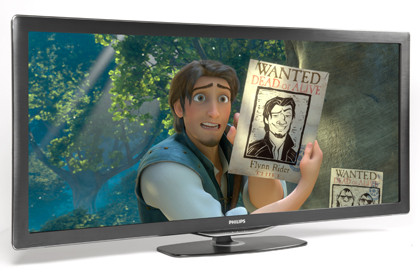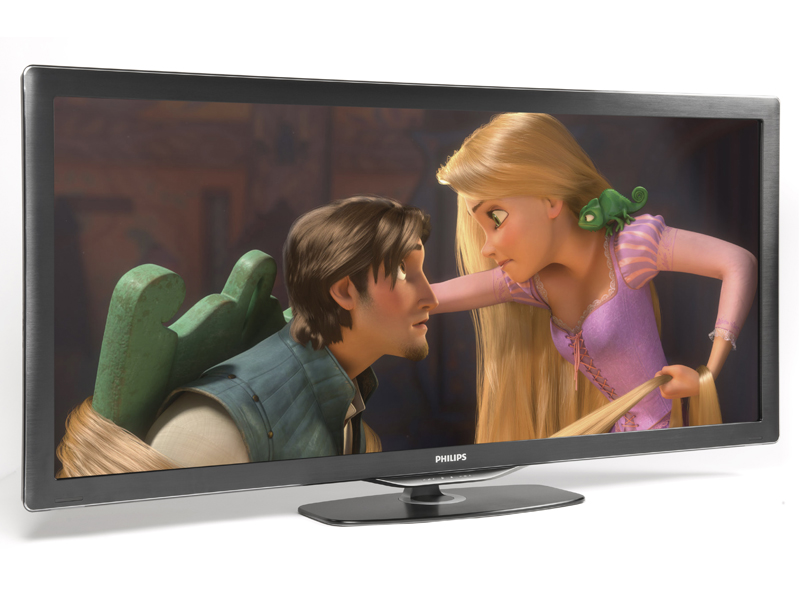Why you can trust TechRadar

Philips' high-end screens have long been renowned for their excellent hi-def pictures and the Cinema 21:9 Platinum continues that tradition. Feed it a Blu-ray movie and the TV revels in it. HBO's WWII series, The Pacific, looks simply stunning, with clear, sharp images free from noise, with well-resolved, bright, natural colours and some of the most captivating black levels yet seen from an LCD screen.
The result is a cinematic experience that'll have you engrossed. In particular, the rear-mounted LED system ensures that the light pooling often seen on edge LED models is practically non-existent, so there's little to complain about, even with stern test scenes like white text moving across a black background.
These images are achieved with the TV's Cinema picture preset, which seems pretty spot on (it even deselects Perfect Natural Motion – so you know you're watching your source material at the frame rate it was filmed). Anyone with a predilection for insanely saturated colours and artificial-looking smooth motion can call up the Vivid setting.
The engrossing nature of the Cinema 21:9 Platinum's pictures is increased by two further things – the Ambilight feature and the unique aspect ratio. Ambilight is, undoubtedly, a gimmick designed to help Philips shift some TVs, but it's one that works; the sympathetic lighting really does heighten your sense of immersion.
The same applies to watching widescreen 2.40:1 movies on this cinemascope screen. Using the Cinema 21:9 preset, the black bars disappear, the image fills the screen and everything just seems, well… bigger. It's hard to pinpoint exactly why it's so impressive, but believe us, it is. And purists not sure if they want their full HD sources fiddled with to fit the 2,560 x 1,080-pixel panel can stick with the pixel-matching 'unscaled' option. But where's the fun in that?
The good news continues with 3D. Pop on one of the two pairs of supplied 3D glasses (which aren't the most comfortable or stylish ones around), plug in a 3D deck and dim the lights and you'll be rewarded with one of the most impressive 3D displays around.
The Cinema 21:9 Platinum's blisteringly bright image works to overcome the darkening effect of the 3D specs and pictures are hardly blighted by the current 3D bugbear of crosstalk. The opening sequences of Monster House, where trees in the background often exhibit ghosting on other LCD-based 3DTVs are almost completely crystal clear.
One thing to note about the screen's 3D performance is that it's much better with Ambilight switched off. Even though Philips has adjusted its light emitting technology so that it doesn't cause flicker when the TV is watched with the active shutter glasses, here the effect proves a distraction. 3D requires you to focus on the TV's screen, and nothing else; the soft glowing halo only serves to draw attention to the artifice of the 3D experience.
Freeview pictures are the TV's weak link. With no integrated HD tuner, you're left watching low-res channels on a massive screen and that brings with it a few picture issues. For instance, mosquito noise is visible around the characters in The Sarah Jane Chronicles on BBC One, as well as some rather unsubtle colour banding.
Of course, Freeview was not devised to be watched on supersize TVs, so it's not the Philips' fault, but these defects serve to highlight the Cinema 21:9 Platinum's one major weakness – the lack of a Freeview HD tuner.
Current page: Philips Cinema 21:9 Platinum: Picture
Prev Page Philips Cinema 21:9 Platinum: Features Next Page Philips Cinema 21:9: Sound and ease of use